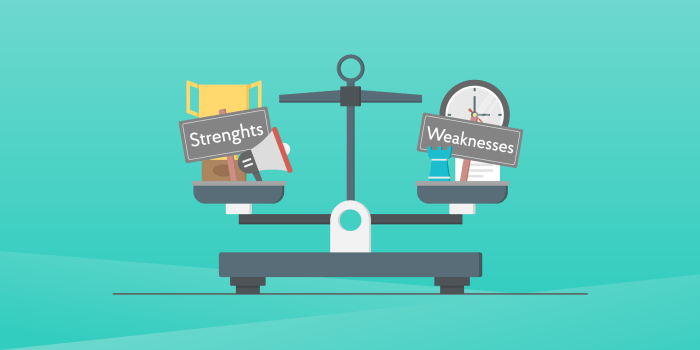All of the following are benefits of swot analysis except – As the adage goes, “All that glitters is not gold.” While SWOT analysis has garnered widespread acclaim as a strategic planning tool, it is imperative to acknowledge its limitations. This article delves into the nuances of SWOT analysis, exploring the exceptions to its purported benefits, thereby providing a comprehensive understanding of its strengths and weaknesses.
SWOT analysis, an acronym for Strengths, Weaknesses, Opportunities, and Threats, is a structured framework for evaluating a company’s internal and external environment. It helps organizations identify their competitive advantages, vulnerabilities, potential growth opportunities, and potential risks. However, despite its widespread adoption, SWOT analysis is not without its drawbacks.
1. Understanding SWOT Analysis: All Of The Following Are Benefits Of Swot Analysis Except

SWOT analysis is a strategic planning tool that helps organizations identify and evaluate their internal and external strengths, weaknesses, opportunities, and threats. It provides a comprehensive overview of an organization’s competitive position and helps decision-makers develop strategies to improve performance.
Components of SWOT Analysis, All of the following are benefits of swot analysis except
- Strengths:Internal factors that give an organization an advantage over its competitors, such as a strong brand reputation, skilled workforce, or efficient operations.
- Weaknesses:Internal factors that hinder an organization’s performance, such as lack of innovation, weak marketing, or high operating costs.
- Opportunities:External factors that present potential growth opportunities for an organization, such as new market segments, technological advancements, or changes in consumer behavior.
- Threats:External factors that pose risks to an organization’s performance, such as increased competition, economic downturns, or regulatory changes.
Applications of SWOT Analysis
- Strategic Planning:SWOT analysis helps organizations develop long-term strategies that align with their strengths, weaknesses, opportunities, and threats.
- Market Analysis:SWOT analysis can be used to assess the competitive landscape and identify potential market opportunities and threats.
- Product Development:SWOT analysis can inform product development decisions by identifying customer needs and competitive advantages.
- Risk Management:SWOT analysis can help organizations identify and mitigate potential risks to their operations.
Limitations and Challenges of SWOT Analysis
- Subjectivity:SWOT analysis can be subjective, as it relies on the judgments and perceptions of those conducting the analysis.
- Lack of Quantifiable Data:SWOT analysis often relies on qualitative data, which can make it difficult to quantify the impact of identified strengths, weaknesses, opportunities, and threats.
- Complexity:Conducting a thorough SWOT analysis can be a complex and time-consuming process.
2. Benefits of SWOT Analysis

SWOT analysis offers numerous benefits for organizations, including:
| Benefit | Example |
|---|---|
| Improved Decision-Making: SWOT analysis provides a framework for evaluating options and making informed decisions based on a comprehensive understanding of the organization’s strengths, weaknesses, opportunities, and threats. | A company might use SWOT analysis to decide whether to launch a new product or enter a new market. |
| Enhanced Strategic Planning: SWOT analysis helps organizations develop strategic plans that are aligned with their capabilities and the external environment. | A non-profit organization might use SWOT analysis to develop a strategic plan to increase its impact on the community. |
| Increased Competitiveness: SWOT analysis enables organizations to identify and exploit their competitive advantages while mitigating their weaknesses. | A retail company might use SWOT analysis to identify ways to differentiate itself from competitors and increase market share. |
| Risk Management: SWOT analysis helps organizations identify and manage potential risks to their operations. | A healthcare provider might use SWOT analysis to identify and mitigate risks to patient safety. |
3. Exceptions to SWOT Analysis Benefits
While SWOT analysis generally offers significant benefits, there are some exceptions to its effectiveness:
Statement: “All of the following are benefits of SWOT analysis except”
This statement is an exception to the general benefits of SWOT analysis because it implies that there is at least one benefit that SWOT analysis does not provide.
Potential Exceptions to SWOT Analysis Benefits
- Unrealistic Expectations:SWOT analysis cannot guarantee success or eliminate all risks. It is a tool that provides insights, but organizations must still execute their strategies effectively.
- Overreliance on Subjective Data:If SWOT analysis relies heavily on subjective data, it may not provide a reliable basis for decision-making.
- Limited Scope:SWOT analysis only considers a snapshot in time and may not account for future changes in the internal or external environment.
4. Alternative Methods to SWOT Analysis

In some cases, alternative methods may be more appropriate than SWOT analysis. These methods include:
PEST Analysis
PEST analysis examines political, economic, social, and technological factors that can impact an organization’s operations.
Porter’s Five Forces
Porter’s Five Forces analyzes the competitive intensity of an industry by examining the threat of new entrants, the bargaining power of buyers and suppliers, the threat of substitutes, and the rivalry among existing competitors.
Comparison of Methods
| Method | Advantages | Disadvantages |
|---|---|---|
| SWOT Analysis | – Comprehensive view of internal and external factors- Provides a framework for decision-making- Easy to understand and apply | – Subjective- Lack of quantifiable data- Complex |
| PEST Analysis | – Focuses on external factors- Useful for identifying macro-level trends- Simple to conduct | – Does not consider internal factors- May not provide specific actionable insights- Can be limited in scope |
| Porter’s Five Forces | – Analyzes industry competition- Identifies key drivers of profitability- Provides insights for competitive strategy | – Complex to conduct- Requires industry-specific knowledge- May not account for all relevant factors |
When to Use Alternative Methods
- PEST analysis is suitable for assessing the external environment and identifying macro-level trends.
- Porter’s Five Forces is appropriate for analyzing industry competition and developing competitive strategies.
Q&A
What are the potential exceptions to the benefits of SWOT analysis?
SWOT analysis can be limited by factors such as its reliance on subjective judgments, its static nature, and its inability to capture complex or dynamic environments.
When should organizations consider using alternative methods to SWOT analysis?
Alternative methods may be more appropriate when the environment is highly uncertain, when the organization lacks internal consensus, or when a more comprehensive analysis is required.